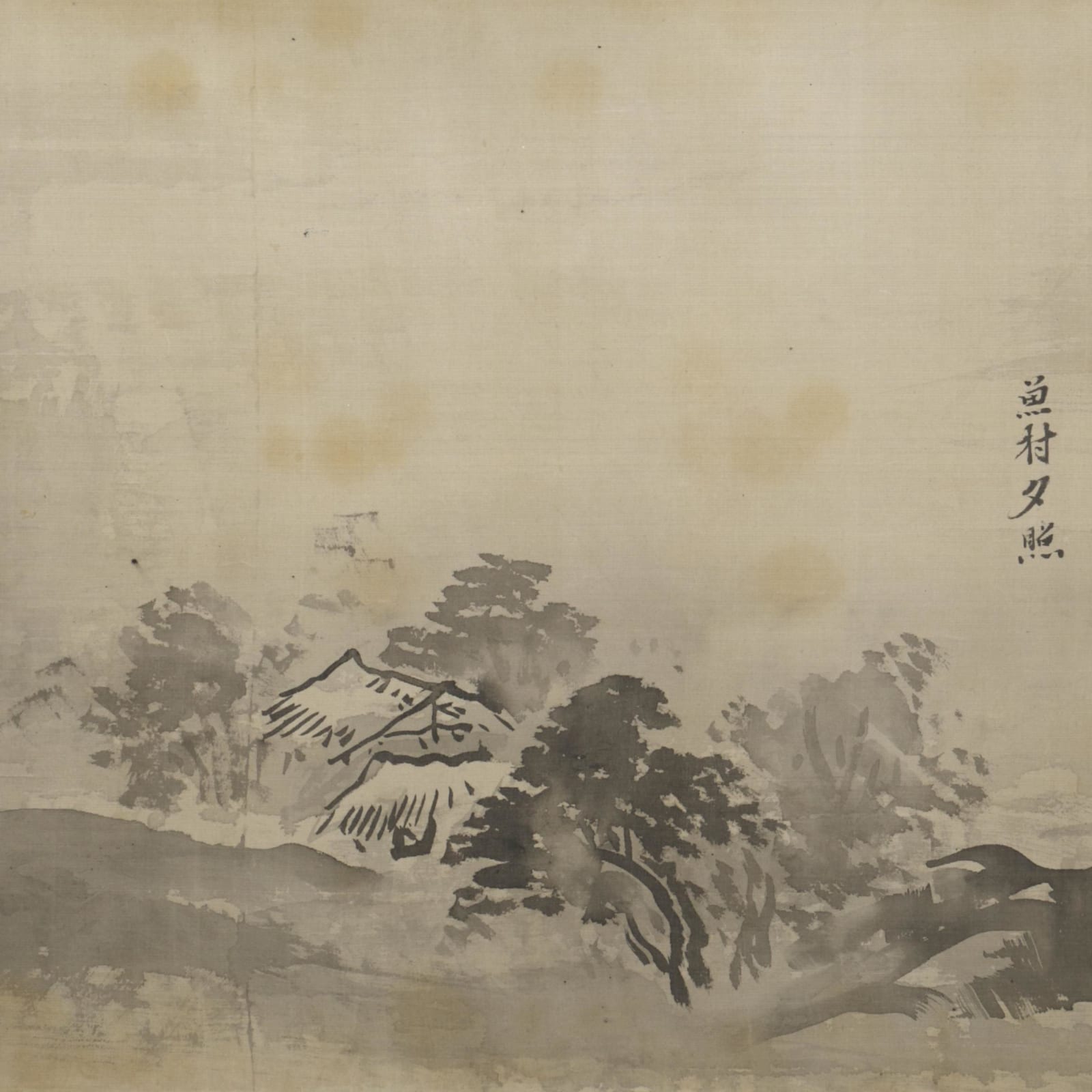Kanō Tan’yū (1602–1674)
Eight Views of the Xiao and Xiang
Ink on silk, handscroll
Dated 1661
Double boxed
Seal: Morinobu
29.5 x 476 cm
29.5 x 542 cm (overall)
Dated 1661
Double boxed
Seal: Morinobu
29.5 x 476 cm
29.5 x 542 cm (overall)
Further images
“Eight Views of the Xiao and Xiang” (hereinafter “Eight Views”) is a classical subject of Chinese ink painting. This scroll is brushed in the gyo, or semi-formal, style of sansui painting. Straw-thatched roofs visible among trees in the scenes of “Mountain Market in Clearing Mist” and “Fishing Village in Evening Glow” is originated in the “Eight Views” by Muqi, a monk and painter of the Southern Song dynasty, yet is fully transformed into the Tanyu style.
In the “Evening Bell from Mist-shrouded Temple” scene, a temple is depicted on a rocky hill that slopes down to the left. Tanyu employed almost the same composition in other twoo versions of “Eight views” in an American private collection and the Shizuoka Prefectural Museum of Art, though right and left are reversed in the latter. Those paintings, rendered the shin, or formal style, are more detailed than the present one. He must have employed the same composition of the shin style paintings, despite executed in a simplified style. A preceding example of the composition can be found in the wall paintings in the Kuroki-shoin of the Nagoya-jo Castle.
A tree in the foreground of the “Autumn Moon over Lake Dongting” scene is drawn in black. Such an expression can be traced to the Snow Landscape by Liang Kai, a Chinese painter of the Southern Song dynasty, in the Tokyo National Museum collection. It is sometimes adopted in the “River and Snow” scene of the “Eight Views” by Japanese painters. The tree in the present painting, however, is placed in the autumn landscape with a full moon. It is not covered with snow, but backlit by the moon. Tanyu boldly tried a backlighting technique here, which is pointed out to have been used also in the above-mentioned “Eight Views” in the American private collection.
Kano Tan’yu (painter; 1602–1674)
Also known as Uneme; Morinobu; Byakurenshi; Seimei; etc.
Early Edo period painter and the progenitor of the Kajibashi Kano School. Eldest son of Kano Takanobu, and elder brother of Kano Naonobu and Kano Yasunobu. Brought new life to and revived the School. Designated as hogen, the second rank in the Buddhist priest hierarchy, and was named ‘Tan’yusai.’
In the “Evening Bell from Mist-shrouded Temple” scene, a temple is depicted on a rocky hill that slopes down to the left. Tanyu employed almost the same composition in other twoo versions of “Eight views” in an American private collection and the Shizuoka Prefectural Museum of Art, though right and left are reversed in the latter. Those paintings, rendered the shin, or formal style, are more detailed than the present one. He must have employed the same composition of the shin style paintings, despite executed in a simplified style. A preceding example of the composition can be found in the wall paintings in the Kuroki-shoin of the Nagoya-jo Castle.
A tree in the foreground of the “Autumn Moon over Lake Dongting” scene is drawn in black. Such an expression can be traced to the Snow Landscape by Liang Kai, a Chinese painter of the Southern Song dynasty, in the Tokyo National Museum collection. It is sometimes adopted in the “River and Snow” scene of the “Eight Views” by Japanese painters. The tree in the present painting, however, is placed in the autumn landscape with a full moon. It is not covered with snow, but backlit by the moon. Tanyu boldly tried a backlighting technique here, which is pointed out to have been used also in the above-mentioned “Eight Views” in the American private collection.
Kano Tan’yu (painter; 1602–1674)
Also known as Uneme; Morinobu; Byakurenshi; Seimei; etc.
Early Edo period painter and the progenitor of the Kajibashi Kano School. Eldest son of Kano Takanobu, and elder brother of Kano Naonobu and Kano Yasunobu. Brought new life to and revived the School. Designated as hogen, the second rank in the Buddhist priest hierarchy, and was named ‘Tan’yusai.’









